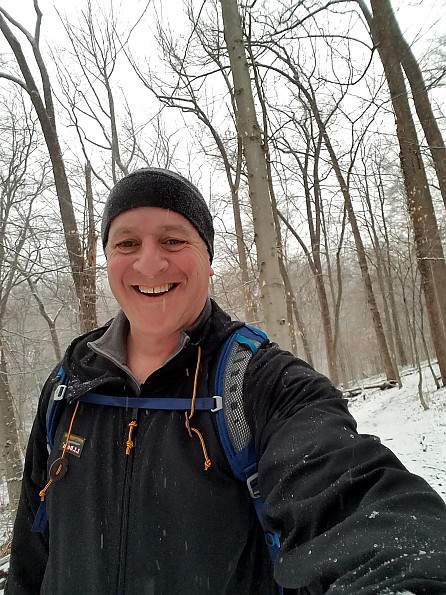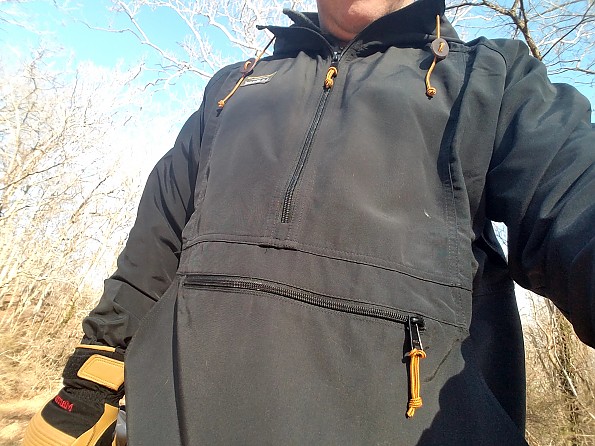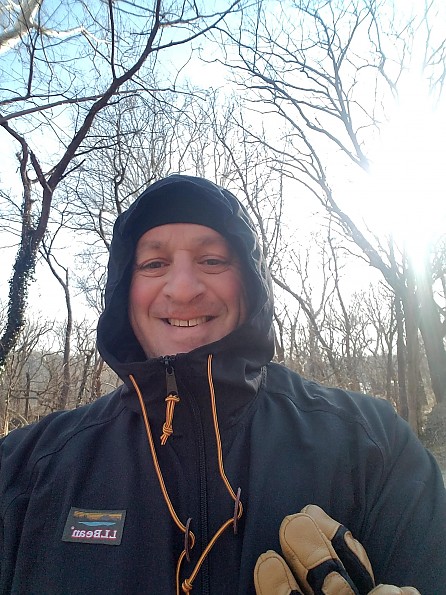L.L.Bean Mountain Classic Anorak

A simple, inexpensive but highly functional wind shell. The nylon shell is wind and water resistant but will soak through and will let air through in a stiff breeze. Zipper pulls and some cords seem intended more for town or campus but do the job. On the plus side, highly breathable and apparently built to last. Hood is best used with a ballcap or it will fall down over your eyes.
Pros
- Anorak style
- Wind and water resistant
- Price
- Very breathable
- Durability
Cons
- Could have been made lighter weight
- Not waterproof
- hard wind gets through
In high school and until I lost it in college, the LL Bean anorak was one of my favorite shell jackets. Lightweight, all-purpose, indestructible, I wore it all season, all the time. The last couple of years, Bean reintroduced the anorak, and I recently decided to give it a try.
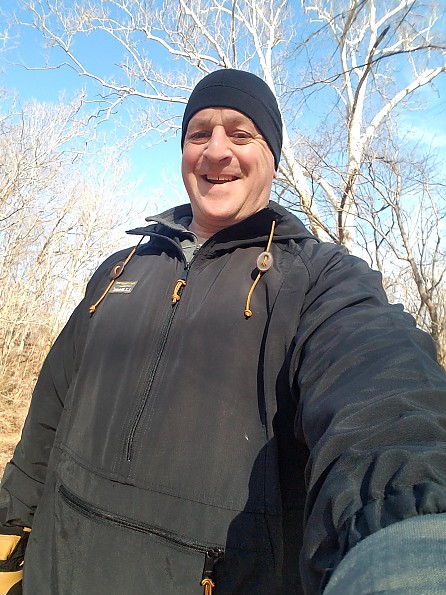 LL Bean's Mountain Anorak is an old school windbreaker, basically. It's a pullover with a half-zip in front. You can pull the hood tight with a bootlace-looking string that has leather disks to keep it tight, elastic cuffs, and an elastic shock-cord you can tighten at the hem. Like most anoraks, it has a big handwarmer pocket in the center and a pretty big zippered pocket above the handwarmer pocket. The pockets are a big plus—roomy, easy to store a lot of stuff, and things don't flap around the same way as some side pockets can.
LL Bean's Mountain Anorak is an old school windbreaker, basically. It's a pullover with a half-zip in front. You can pull the hood tight with a bootlace-looking string that has leather disks to keep it tight, elastic cuffs, and an elastic shock-cord you can tighten at the hem. Like most anoraks, it has a big handwarmer pocket in the center and a pretty big zippered pocket above the handwarmer pocket. The pockets are a big plus—roomy, easy to store a lot of stuff, and things don't flap around the same way as some side pockets can.
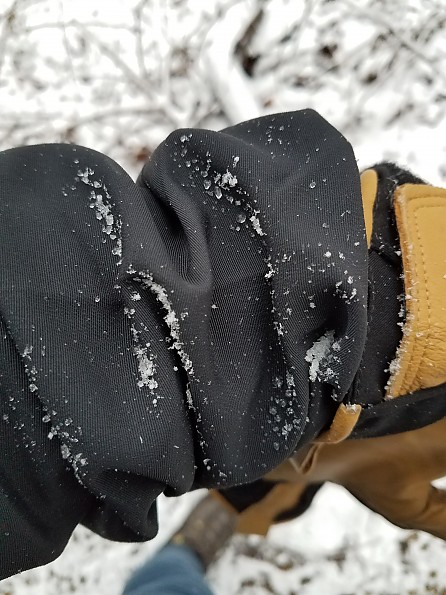
Fit is somewhat more narrow than I remember, but I'm not as narrow as I used to be! I chose a men's XXL because I didn't think the XL, which fit fine over a light base layer, would give me much room for additional layering. The XXL fits with a little extra room to comfortably layer a mid-weight fleece under it; the sleeves are still a good length.
On a digital hand scale, my jacket weighs about 14.5 ounces. That is hardly lightweight compared to Patagonia's Houdini at 4.5 ounces. The single layer nylon is quite a bit more sturdy than the ultralight windshirts, so it should be able to take more of a beating.
TESTING CONDITIONS
I have worn this jacket for a good portion of winter 2017-18. We had snow occasionally this winter but quite a bit of rain and wind. We also had weather ranging from single digits to fifty degree sunny days in February. For the most part, I wore the jacket on hikes over a short or long sleeve base layer, and I added a fleece under it on a few particularly cold days. I generally wore a day pack while hiking in it.
DURABILITY
It seems well-made and shows no wear from a few months of walking under shoulder straps. The added ounces compared to ultralight windshirts should make it better suited for walking off-trail, which I did from time to time this winter.
BREATHABILITY
A significant advantage of having a non-waterproof jacket is its ability to vent moisture under strenuous conditions. I haven't yet found a waterproof/breathable jacket that can compete with a nylon wind shirt in this function, even with generous armpit zippers. This is as good as or better than the Houdini about letting water vapor escape, as I noted on a relatively warm hike up nearby Sugarloaf Mountain. This might be my first choice for a shoulder season wind shirt if i'm not sure about layering needs.
WATER RESISTANCE
About what you would expect from a nylon jacket engineered to feel more like cotton. Morning mist and fog don't make a dent in this jacket; light rain initially rolls off but will eventually start getting the nylon wet. It clearly has some kind of DWR applied. Not the best choice for a hard rain, but for spotty light rain, it's fine. Ballpark, I would say 3 out of 5.
WIND RESISTANCE
An advantage of some of the lighter nylon windshirts like the Houdini is their tight weave, which is pretty solid in the wind resistance category. This jacket feels like it lets some more air in than that. Short of really strong gusts, it cuts the wind nicely. Personally, I like a little bit of air permeability for a jacket that I want to breathe moisture out. As a spring/fall layer to put on over a t-shirt or light base layer on a breezy day, a really great option. See closeup photo above with snow on the sleeve. About 3.5 to 4 out of 5.
HOOD
Hasn't changed much from the anorak of my youth. You can pull it tight, but there is no way to shrink it from the rear, and it tends to fall down over your eyes unless you wear a ballcap or something with a bill to keep the hood out of the way. Simple and functional but not the best hood around.3 out of 5.
This jacket does a lot of things pretty well. Compared to the wind shirt I think of as the gold standard, it is somewhat heavier, roomier, about as water resistant and breathable, and a tad less windproof, but it also costs just a little more than half. I also find the anorak pockets particularly convenient for stowing things while on the move. If you want or need the lightest and latest and don't have particular concerns about layering underneath, pocket accessibility, or possible durability issues from thin nylon shell fabric, think about Patagonia's Houdini and try to find it on sale. Otherwise, maybe save a few dollars and get a jacket that you might just as well wear to your local watering hole as carry on the trail.
Source: bought it new
Price Paid: $59
Perfect description. I cross country ski and snowshoe and am old school. I have a North Face from 1978 I "outgrew."
Pros
- Light
- Water resistant
- Wind resistant
- Waddable
- Good looking
- Well made
- Pockets
Cons
- None for my purposes.
There for quite a few years, the only anorak I could find were tactical gear...but now they are back in colors other than coyote and camo and better made. I wear Patagonia AND the LL Bean Primaloft bivys with a hood under these and it is a perfect combination over a base layer and different weights mid layers.
I live in MT and temps run from single digits below (my personal limits) to 30, like this last weekend in W Yellowstone with 8 inches of snow during the the day we were there. This approach covers them all with the half zips letting heat out and removable layers that pack easily.
This is a perfect outer in our conditions with the powdery snow generally not sticking and protecting from falls. Great description.
Background
Wearing as outer layer for cross-country skiing and snowshoeing in windy, snowy conditions.
Source: bought it new
Price Paid: 50 bucks with discounts
Your Review
Where to Buy
You May Like
Specs
| Men's | |
|---|---|
| Price |
MSRP: $59.00 Current Retail: $44.99-$59.00 Historic Range: $44.99-$59.00 Reviewers Paid: $50.00-$59.00 |
| Women's | |
|---|---|
| Price |
Current Retail: $44.99-$59.00 Historic Range: $29.99-$59.00 |


